Exploring Port–City Relationships: A Bibliometric and Content Analysis
Abstract
1. Introduction
- RQ1: What are the most influential journals on port–city relationships?
- RQ2: Which countries and geographic regions play a substantial role in the research on port–city relationships?
- RQ3: What research themes are addressed in the existing articles on port–city relationships?
- RQ4: How do various analytical approaches and methodologies contribute to assessing the relationship between a port and a city?
- RQ5: What themes and indicators significantly influence the relations between a port and a city?
2. Methodology
3. Results and Discussions
3.1. Descriptive Analysis
3.2. Methodological Approach
3.3. The Study Themes: Driving Themes of PCRs
3.3.1. Physical–Spatial
- Strategic and Geopolitical Position of Port Cities
- Quality of Life and Desirable Urban Planning
- Contradiction Physical–Spatial and Integration of a Port and a City
3.3.2. Infrastructure Support and Development
- Development of Existing Facilities and Construction of New Facilities
- Development of Advanced Multimodal Transportation Infrastructure in Ports
- Quantity and Quality of Transit Corridors (Rail, Road, and Air) for Interactions with Hinterlands
- Development of Terminal and Warehousing Facilities and Infrastructure
3.3.3. Economic
- Development of Various Types of Industrial and Production Activities in Ports and their Local Ports
- Amount of Income, Expenditure, and Investment in Port Cities
- Quantity and Quality of Financial Interactions and Commercial Policies of Ports
- Growth and Diversity of Employment and Enhancement of Workers’ Welfare in Port Cities
3.3.4. Managerial-Social
- Improving the Management and Application of Information Technology in Loading, Unloading, and Storing Goods
- Reforming the Method of Management and Regional Planning of Ports
- Promotion of Local Governance in PCRs
- Promotion of National Management and International Interaction of Ports
- Social Dissonance or Convergence between a City and a Port
- Increasing the rate of population growth and migration to the port city
- Cultural and Historical Identity of Ports
3.3.5. Environment
- Using Cheaper, Less-Polluting, and Clean and Renewable Energies in Port cities
- Environmental Protection and Sustainable Development of Port Cities
4. Conclusions
Author Contributions
Funding
Institutional Review Board Statement
Informed Consent Statement
Data Availability Statement
Acknowledgments
Conflicts of Interest
References
- Hammadi, L.J.; Saleh, O.A. The impact of trade relations on the prosperity of the economic activity of the ports of Central Morocco (Century 5-7 AH/11-13 AD). AL-ADAB J. 2022, 2. [Google Scholar] [CrossRef]
- Aritua, B.; Chiu, H.; Cheng, L.; Farrell, S. Developing China’s Ports: How the Gateways to Economic Prosperity Were Revived; World Bank Publications: Washington, DC, USA, 2022. [Google Scholar] [CrossRef]
- Arasteh, A.; Dadashpoor, H.; Taghvaee, A. Explaining the Geopolitical Evolution of Ports—Hinterland Connections in Iran; A Historical Comparative Approach. Int. Q. J. Geopolit. 2016, 12, 183–218. [Google Scholar]
- Notteboom, T.; Pallis, A.; Rodrigue, J.-P. Port Economics, Management and Policy; Routledge: London, UK, 2022. [Google Scholar] [CrossRef]
- Meijers, E. Polycentric urban regions and the quest for synergy: Is a network of cities more than the sum of the parts? Urban Stud. 2005, 42, 765–781. [Google Scholar] [CrossRef]
- Li, S.; Haralambides, H.; Zeng, Q. Economic forces shaping the evolution of integrated port systems-The case of the container port system of China’s Pearl River Delta. Res. Transp. Econ. 2022, 94, 101183. [Google Scholar] [CrossRef]
- Carpenter, A.; Lozano, R. European Port Cities in Transition; Springer: New York, NY, USA, 2020. [Google Scholar] [CrossRef]
- Wiegmans, B.W.; Louw, E. Changing port–city relations at Amsterdam: A new phase at the interface? J. Transp. Geogr. 2011, 19, 575–583. [Google Scholar] [CrossRef]
- Ducruet, C.; Lee, S.-W. Frontline soldiers of globalisation: Port–city evolution and regional competition. GeoJournal 2006, 67, 107–122. [Google Scholar] [CrossRef]
- Merk, O. The Competitiveness of Global Port-Cities: Synthesis Report; OECD: Paris, France, 2013. [Google Scholar]
- Lam, J.S.L.; Yap, W.Y. A stakeholder perspective of port city sustainable development. Sustainability 2019, 11, 447. [Google Scholar] [CrossRef]
- Daamen, T.A.; Vries, I. Governing the European port–city interface: Institutional impacts on spatial projects between city and port. J. Transp. Geogr. 2013, 27, 4–13. [Google Scholar] [CrossRef]
- Hoyle, B.S. The port—City interface: Trends, problems and examples. Geoforum 1989, 20, 429–435. [Google Scholar] [CrossRef]
- Notteboom, T.E.; Rodrigue, J.-P. Port regionalization: Towards a new phase in port development. Marit. Policy Manag. 2005, 32, 297–313. [Google Scholar] [CrossRef]
- Hein, C. The Port Cityscape: Spatial and institutional approaches to port city relationships. PORTUSplus 2019, 8. [Google Scholar]
- Andrade, M.J.; Costa, J.P. Touristification of European port-cities: Impacts on local populations and cultural heritage. In European Port Cities in Transition: Moving towards More Sustainable Sea Transport Hubs; Springer: New York, NY, USA, 2020; pp. 187–204. [Google Scholar] [CrossRef]
- Guo, J.; Qin, Y. Coupling characteristics of coastal ports and urban network systems based on flow space theory: Empirical evidence from China. Habitat Int. 2022, 126, 102624. [Google Scholar] [CrossRef]
- Broeze, F. Brides of the Sea: Port Cities of Asia from the 16th–20th Centuries; UNSW Press: Randwick, Australia, 1989. [Google Scholar]
- Daamen, T. Sustainable development of the European port-city interface. In Proceedings of the ENHR-Conference, Rotterdam, The Netherland, 25–28 June 2007; pp. 25–28. [Google Scholar]
- Norcliffe, G.; Bassett, K.; Hoare, T. The emergence of postmodernism on the urban waterfront: Geographical perspectives on changing relationships. J. Transp. Geogr. 1996, 4, 123–134. [Google Scholar] [CrossRef]
- Reeves, P.; Broeze, F.; McPherson, K. McPherson, K. Studying the Asian port city. In Brides of the sea: Port cities of Asia from the 16th–20th centuries; University of Hawaii Press: Honolulu, HI, USA, 1989; Volume 16, pp. 29–53. [Google Scholar]
- Ducruet, C. A metageography of port-city relationships. In Ports, Cities, and Global Supply Chains; Routledge: London, UK, 2007; pp. 157–172. [Google Scholar]
- Zheng, Y.; Zhao, J.; Shao, G. Port city sustainability: A review of its research trends. Sustainability 2020, 12, 8355. [Google Scholar] [CrossRef]
- Wagner, N. Sustainability in port cities—A bibliometric approach. Transp. Res. Procedia 2019, 39, 587–596. [Google Scholar] [CrossRef]
- Foroughi, M.; de Andrade, B.; Roders, A.P.; Wang, T. Public participation and consensus-building in urban planning from the lens of heritage planning: A systematic literature review. Cities 2023, 135, 104235. [Google Scholar] [CrossRef]
- Micelli, E.; Ostanel, E.; Lazzarini, L. “Wanna Be Provoked”: Inner Peripheries Generators of Social Innovation in the Italian Apennine. Land 2023, 12, 829. [Google Scholar] [CrossRef]
- Tranfield, D.; Denyer, D.; Smart, P. Towards a methodology for developing evidence-informed management knowledge by means of systematic review. Br. J. Manag. 2003, 14, 207–222. [Google Scholar] [CrossRef]
- Cook, D. Les articles de revues: Vers des méthodes plus rigoureuses et des comptes rendus plus précis. Can. J. Anaesth 1997, 44, 350–353. [Google Scholar] [CrossRef]
- Dadashpoor, H.; Malekzadeh, N. Driving factors of formation, development, and change of spatial structure in metropolitan areas: A systematic review. J. Urban Manag. 2020, 9, 286–297. [Google Scholar] [CrossRef]
- McKane, R.G.; Hess, D. The impact of ridesourcing on equity and sustainability in North American cities: A systematic review of the literature. Cities 2023, 133, 104122. [Google Scholar] [CrossRef]
- Liu, J.; Kong, Y.; Li, S.; Wu, J. Sustainability assessment of port cities with a hybrid model-empirical evidence from China. Sustain. Cities Soc. 2021, 75, 103301. [Google Scholar] [CrossRef]
- Chowdhury, M.M.H.; Haque Munim, Z. Dry port location selection using a fuzzy AHP-BWM-PROMETHEE approach. Marit. Econ. Logist. 2023, 25, 301–329. [Google Scholar] [CrossRef]
- Wanqing, S. Evaluation of international port city based on fuzzy comprehensive evaluation. J. Intell. Fuzzy Syst. 2020, 38, 7027–7032. [Google Scholar] [CrossRef]
- Liu, J.; Zhou, J.; Liu, F.; Yue, X.; Kong, Y.; Wang, X. Interaction analysis and sustainable development strategy between port and city: The case of Liaoning. Sustainability 2019, 11, 5366. [Google Scholar] [CrossRef]
- Činčikaitė, R.; Čižiūnienė, K.; Meidutė-Kavaliauskienė, I. Assessment of the economic security of Baltic port cities’ competitiveness. Probl. Perspect. Manag. 2023, 21, 443–453. [Google Scholar] [CrossRef]
- Bazaras, D.; Palšaitis, R.; Petraška, A.; Zvaigzne, A. Criteria system of emergency situations risks assessment in the Baltic sea ports. Transp. Telecommun. J. 2017, 18, 275–281. [Google Scholar] [CrossRef][Green Version]
- Grindlay, A.L.; Martínez-Hornos, S. Cruise ships and urban mobility in Mediterranean Spain. Int. J. Transp. Dev. Integr. 2022, 6, 12–24. [Google Scholar] [CrossRef]
- Ducruet, C. Revisiting urban hierarchy and specialization from a maritime perspective. Marit. Policy Manag. 2020, 47, 371–387. [Google Scholar] [CrossRef]
- López-Bermúdez, B.; Freire-Seoane, M.J.; Pais-Montes, C.; Lesta-Casal, E. Port-city development: The spanish case. Trans. Marit. Sci. 2020, 9, 82–89. [Google Scholar] [CrossRef]
- Owusu-Mfum, S.; Hudson, M.D.; Osborne, P.E.; Roberts, T.J.; Zapata-Restrepo, L.M.; Williams, I.D. Atmospheric pollution in port cities. Atmosphere 2023, 14, 1135. [Google Scholar] [CrossRef]
- Seo, J.K.; Cho, M.; Skelton, T. “Dynamic Busan”: Envisioning a global hub city in Korea. Cities 2015, 46, 26–34. [Google Scholar] [CrossRef]
- Chia-Hong, L.-L. The interaction between the port and Kaohsiung city: Economy, institution and power. City Cult. Soc. 2013, 4, 21–35. [Google Scholar] [CrossRef]
- Roberts, T.; Williams, I.; Preston, J.; Clarke, N.; Odum, M.; O’Gorman, S. Ports in a storm: Port-city environmental challenges and solutions. Sustainability 2023, 15, 9722. [Google Scholar] [CrossRef]
- Malkus, R.; Liebuvienė, J.; Jokubyniėnė, V. Inland water transport applicability for sustainable sea port hinterland infrastructure development. Klaipeda sea-port case. Transp. Probl. 2020, 15, 25–31. [Google Scholar] [CrossRef]
- Cheung, S.M.S.; Yip, T.L. Port city factors and port production: Analysis of Chinese ports. Transp. J. 2011, 50, 162–175. [Google Scholar] [CrossRef]
- Chen, J.; Fei, Y.; Zhu, Y.; Zhang, F. Allometric relationship between port throughput growth and urban population: A case study of Shanghai port and Shanghai city. Adv. Mech. Eng. 2018, 10, 1687814018760933. [Google Scholar] [CrossRef]
- Jiang, M.; Zhao, S.; Jia, P. The spatial spillover effect of seaport capacity on export trade: Evidence from China pilot free trade zones. Ocean Coast. Manag. 2023, 245, 106879. [Google Scholar] [CrossRef]
- Funke, M.; Yu, H. The emergence and spatial distribution of Chinese seaport cities. China Econ. Rev. 2011, 22, 196–209. [Google Scholar] [CrossRef]
- Zhao, Q.; Xu, H.; Wall, R.S.; Stavropoulos, S. Building a bridge between port and city: Improving the urban competitiveness of port cities. J. Transp. Geogr. 2017, 59, 120–133. [Google Scholar] [CrossRef]
- Gu, Y.; Liu, W.; Loh, H.S. Port Efficiency Based on the Super-Efficiency EBM-DEA-SDM Model: Empirical Evidence from China. Future Transp. 2022, 3, 23–37. [Google Scholar] [CrossRef]
- Wu, B.; Gu, G.; Zhang, W.; Zhang, L.; Lu, R.; Pang, C.; Huang, J.; Li, H. Multi-scale influencing factors and prediction analysis: Dongxing port–city relationship. Int. J. Environ. Res. Public Health 2022, 19, 9068. [Google Scholar] [CrossRef] [PubMed]
- Shan, J.; Yu, M.; Lee, C.-Y. An empirical investigation of the seaport’s economic impact: Evidence from major ports in China. Transp. Res. E 2014, 69, 41–53. [Google Scholar] [CrossRef]
- Cong, L.-Z.; Zhang, D.; Wang, M.-L.; Xu, H.-F.; Li, L. The role of ports in the economic development of port cities: Panel evidence from China. Transp. Policy 2020, 90, 13–21. [Google Scholar] [CrossRef]
- Bedoya-Maya, F.; Calatayud, A. Enhanced port-city interface through infrastructure investment: Evidence from Buenos Aires. Marit. Econ. Logist. 2023, 25, 249–271. [Google Scholar] [CrossRef]
- Tang, J.; Lin, B. Ports and economic development of port cities in Pearl River Delta based on Panel Vector Autoregressive Model. Int. J. Innov. Comput. Inf. Control 2023, 19, 835–843. [Google Scholar] [CrossRef]
- Jarašūnienė, A.; Greičiūnė, L.; Šakalys, A. Research of competitive environment of Klaipėda Seaport comparing to other seaports in the eastern Baltic Sea region. Transport 2012, 27, 5–13. [Google Scholar] [CrossRef]
- Seabrooke, W.; Hui, E.C.; Lam, W.H.; Wong, G.K. Forecasting cargo growth and regional role of the port of Hong Kong. Cities 2003, 20, 51–64. [Google Scholar] [CrossRef]
- Nugraha, A.T.; Waterson, B.J.; Blainey, S.P.; Nash, F.J. Unravelling the dynamics behind the urban morphology of port-cities using a LUTI model based on cellular automata. Comput. Environ. Urban Syst. 2022, 92, 101733. [Google Scholar] [CrossRef]
- Guo, J.; Qin, Y.; Du, X.; Han, Z. Dynamic measurements and mechanisms of coastal port–city relationships based on the DCI model: Empirical evidence from China. Cities 2020, 96, 102440. [Google Scholar] [CrossRef]
- Chen, J.; Zhang, W.; Song, L.; Wang, Y. Coordination between port industry and urban environment. Sci. Total Environ. 2022, 841, 156734. [Google Scholar] [CrossRef]
- Yu, W.; Gang, L.; Mingwu, L. Synergy of ports and cities in the Chengdu-Chongqing Economic Circle and the influencing factors. Sci. Control Eng. 2021, 9, 623–630. [Google Scholar] [CrossRef]
- Lin, B.; Tang, J. Impact of Port-City Coordination Upon Hinterland Economy in Pearl River Delta. Int. J. Innov. Comput. Inf. Control 2023, 19, 289–297. [Google Scholar] [CrossRef]
- Chen, C.; Lam, J.S.L. Sustainability and interactivity between cities and ports: A two-stage data envelopment analysis (DEA) approach. Marit. Policy Manag. 2018, 45, 944–961. [Google Scholar] [CrossRef]
- Kammoun, R.; Abdennadher, C. The Impact of Seaport Competition on Technical Efficiency: Simar–Wilson Analysis of European Container Ports. Trans. Marit. Sci. 2023, 12, 309810. [Google Scholar] [CrossRef]
- Qu, Y.; Kong, Y.; Li, Z.; Zhu, E. Pursue the coordinated development of port-city economic construction and ecological environment: A case of the eight major ports in China. Ocean Coast. Manag. 2023, 242, 106694. [Google Scholar] [CrossRef]
- Luan, W.; Chen, H.; Wang, Y. Simulating mechanism of interaction between ports and cities based on system dynamics: A case of Dalian, China. Chin. Geogr. Sci. 2010, 20, 398–405. [Google Scholar] [CrossRef]
- Zhen, C. Empirical research on the wisdom port-city coupling system. J. Comput. Theor. Nanosci. 2016, 13, 2014–2020. [Google Scholar] [CrossRef]
- Chen, Z. Research on the interaction between innovation and port-city economic system: A case from China. Discret. Dyn. Nat. Soc. 2015, 2015, 692476. [Google Scholar] [CrossRef]
- Yu, L.; Xu, P.; Shi, J.; Chen, J.; Zhen, H. Driving mechanism of port-city spatial relation evolution from an ecological perspective: Case study of xiamen port of China. Sustainability 2020, 12, 2857. [Google Scholar] [CrossRef]
- dos Santos, M.C.; Pereira, F.H. Development and application of a dynamic model for road port access and its impacts on port-city relationship indicators. J. Transp. Geogr. 2021, 96, 103189. [Google Scholar] [CrossRef]
- Chen, H.; Bao, S.; Shen, M.; Ni, D. Does the history of opening ports and trading influence the long-term business credit environment of cities? Evidence from the Yangtze River Delta region of China. PLoS ONE 2023, 18, e0285173. [Google Scholar] [CrossRef]
- Ma, Q.; Jia, P.; She, X.; Haralambides, H.; Kuang, H. Port integration and regional economic development: Lessons from China. Transp. Policy 2021, 110, 430–439. [Google Scholar] [CrossRef]
- Li, Z.; Luan, W.; Zhang, Z.; Su, M. Research on the Interactive Relationship of Spatial Expansion between Estuarine and Coastal Port Cities. Land 2023, 12, 371. [Google Scholar] [CrossRef]
- Zanne, M.; Twrdy, E.; Beškovnik, B. The effect of port gate location and gate procedures on the port-city relation. Sustainability 2021, 13, 4884. [Google Scholar] [CrossRef]
- Xiao, Z.; Lam, J.S.L. A systems framework for the sustainable development of a Port City: A case study of Singapore’s policies. Res. Transp. Bus. Manag. 2017, 22, 255–262. [Google Scholar] [CrossRef]
- Akhavan, M. Development dynamics of port-cities interface in the Arab Middle Eastern world-The case of Dubai global hub port-city. Cities 2017, 60, 343–352. [Google Scholar] [CrossRef]
- Hein, C.; Schubert, D. Resilience and path dependence: A comparative study of the port cities of London, Hamburg, and Philadelphia. J. Urban Hist. 2021, 47, 389–419. [Google Scholar] [CrossRef]
- Debrie, J.; Raimbault, N. The port–city relationships in two European inland ports: A geographical perspective on urban governance. Cities 2016, 50, 180–187. [Google Scholar] [CrossRef]
- Garcia, P.R. The role of the port authority and the municipality in port transformation: Barcelona, San Francisco and Lisbon. Plan. Perspect. 2008, 23, 49–79. [Google Scholar] [CrossRef]
- Daamen, T.A.; Louw, E. The challenge of the Dutch port-city interface. Tijdschr. Econ. Soc. Geogr. 2016, 107, 642–651. [Google Scholar] [CrossRef]
- Van Dijk, H.; Pinheiro, M.A. The changing face of European ports as a result of their evolving use since the nineteenth century. Port. J. Soc. Sci. 2003, 2, 89–103. [Google Scholar] [CrossRef] [PubMed][Green Version]
- Andrade, M.J.; Costa, J.P.; Jiménez-Morales, E. Challenges for european tourist-city-ports: Strategies for a sustainable coexistence in the cruise post-COVID context. Land 2021, 10, 1269. [Google Scholar] [CrossRef]
- Andrade, M.J.; Costa, J.P.; Blasco Lopez, J. 3DPortCityMeasure: Methodology for the comparative study of good practices in port–city integration. Sustainability 2020, 12, 880. [Google Scholar] [CrossRef]
- Tan, T.-Y. Port cities and hinterlands: A comparative study of Singapore and Calcutta. Political Geogr. 2007, 26, 851–865. [Google Scholar] [CrossRef]
- Rossetto Ribeiro, R.; Beloto, G.E. Diagrams as a comparative tool to understand the territorial evolution of port city regions. Eur. Plan. Stud. 2022, 30, 1514–1528. [Google Scholar] [CrossRef]
- Caner Yüksel, Ç. A tale of two port cities: Ayasuluk (Ephesus) and Balat (Miletus) during the Beyliks period. Al-Masāq 2019, 31, 338–365. [Google Scholar] [CrossRef]
- Liebuvienė, J.; Čižiūnienė, K. Comparative Analysis of Ports on the Eastern Baltic Sea Coast. Logistics 2021, 6, 1. [Google Scholar] [CrossRef]
- Ramos, S.J. Planning for competitive port expansion on the US Eastern Seaboard: The case of the Savannah Harbor Expansion Project. J. Transp. Geogr. 2014, 36, 32–41. [Google Scholar] [CrossRef]
- Ramos, S.J. Resilience, path dependence, and the port: The case of Savannah. J. Urban Hist. 2021, 47, 250–271. [Google Scholar] [CrossRef]
- Aouissi, K.B.; Madani, S.; Baptist, V. Morphological Evolution of the Port-City Interface of Algiers (16th Century to the Present). Urban Plan. 2021, 6, 119–135. [Google Scholar] [CrossRef]
- Husain, H.R.; Nafa, H. Socio-economic and geo-political transitions in the Mediterranean Basin and its impact on urban forms of port cities. Civ. Eng. Archit. 2020, 8, 898–907. [Google Scholar] [CrossRef]
- Hilell, K.B.; Allweil, Y. Infrastructure development and waterfront transformations: Physical and intangible borders in Haifa port city. Urban Plan. 2021, 6, 43–57. [Google Scholar] [CrossRef]
- Ünlü, T. Commercial development and morphological change in Mersin from the late nineteenth century to the mid-twenties: Modernization of a mercantile port of exchange in the Eastern Mediterranean. Plan. Perspect. 2012, 27, 81–102. [Google Scholar] [CrossRef]
- Krośnicka, K.A.; Wawrzyńska, A. How the Depths of the Danish Straits Shape Gdańsk’s Port and City Spatial Development. Urban Plan. 2023, 8, 346–362. [Google Scholar] [CrossRef]
- Ünlü, T. Transformation of a Mediterranean port city into a ‘city of clutter’: Dualities in the urban landscape—The case of Mersin. Cities 2013, 30, 175–185. [Google Scholar] [CrossRef]
- Wang, H.; Cheng, G. Traditional urban form and evolutionary mechanisms-Quanzhou and Malacca. Int. J. Adv. Sci. Eng. Inf. Technol. 2018, 8, 508–513. [Google Scholar]
- Ru, S.H. Historical geographies of Korea’s incorporation: The rise of underdeveloped and modernized colonial port cities. J. Hist. Geogr. 2022, 76, 42–55. [Google Scholar] [CrossRef]
- Sydorenko, A. Crimean port-cities and their hinterland connections: The dynamics of change, 1800–1917. Int. J. Marit. Hist. 2021, 33, 668–689. [Google Scholar] [CrossRef]
- Welman, L.; Ferreira, S.L. The co-evolution of Saldanha Bay (town and hinterland) and its Port. Local Econ. 2016, 31, 219–233. [Google Scholar] [CrossRef]
- Hein, C. Port cities and urban wealth: Between global networks and local transformations. Int. J. Glob. Environ. 2014, 13, 339–361. [Google Scholar] [CrossRef]
- Pugliano, G.; Benassai, G.; Benassai, E. Integrating urban and port planning policies in a sustainable perspective: The case study of Naples historic harbour area. Plan. Perspect. 2018, 34, 827–847. [Google Scholar] [CrossRef]
- Ažman Momirski, L. The resilience of the port cities of Trieste, Rijeka, and Koper. J. Urban Hist. 2021, 47, 293–316. [Google Scholar] [CrossRef]
- Kato, H. Elements to foster friendly relationships between ports and towns: Photo analysis over boundaries and over times. WIT Trans. Ecol. Environ. 2018, 227, 31–42. [Google Scholar] [CrossRef]
- Hauser, S.; Zhu, P.; Mehan, A. 160 years of borders evolution in dunkirk: Petroleum, permeability, and porosity. Urban Plan. 2021, 6, 58–68. [Google Scholar]
- Kowalewski, M. Images and spaces of port cities in transition. Space Cult. 2021, 24, 53–65. [Google Scholar] [CrossRef]
- Andrade, M.J.; Costa, J.P.; Jiménez-Morales, E.; Ruiz-Jaramillo, J. A city profile of Malaga: The role of the port-city border throughout historical transformations. Urban Plan. 2021, 6, 105–118. [Google Scholar] [CrossRef]
- Dadashpoor, H.; Taheri, E. The evolution of port-city relations in the era of technological development: Case study of Bandar-Abbas County, Iran. GeoJournal 2023, 88, 2423–2447. [Google Scholar] [CrossRef]
- Abaza, W.; Shalaby, A.-F.; Yehia, M. Constructing a Theoretical Framework of the Urban Transformation Processes of the Port City Interface towards Resilient Egyptian Port Cities. Architecture 2022, 10, 71–92. [Google Scholar] [CrossRef]
- Grossmann, I. Perspectives for Hamburg as a port city in the context of a changing global environment. Geoforum 2008, 39, 2062–2072. [Google Scholar] [CrossRef]
- Teschner, N.A. The battle over the commons in port cities. Urban Geogr. 2019, 40, 918–937. [Google Scholar] [CrossRef]
- De Martino, P. Defending the past by challenging the future: Spatial and institutional path dependencies in the Naples port-city region. Reg. Stud. Reg. Sci. 2020, 7, 108–117. [Google Scholar] [CrossRef]
- Noring, L. Public asset corporation: A new vehicle for urban regeneration and infrastructure finance. Cities 2019, 88, 125–135. [Google Scholar] [CrossRef]
- Van den Berg, R.; De Langen, P.W. Hinterland strategies of port authorities: A case study of the port of Barcelona. Res. Transp. Econ. 2011, 33, 6–14. [Google Scholar] [CrossRef]
- Dong, J.; Liu, H.; Zhao, Y.; Chen, D.; Qiao, Q.; Fan, J. The Development of Khorgas Port in Xinjiang, China and Its Effect on Surrounding Towns. Chin. Geogr. Sci. 2023, 33, 458–473. [Google Scholar] [CrossRef]
- Wang, J.J.; Cheng, M.C. From a hub port city to a global supply chain management center: A case study of Hong Kong. J. Transp. Geogr. 2010, 18, 104–115. [Google Scholar] [CrossRef]
- Van den Berghe, K.; Jacobs, W.; Boelens, L. The relational geometry of the port-city interface: Case studies of Amsterdam, the Netherlands, and Ghent, Belgium. J. Transp. Geogr. 2018, 70, 55–63. [Google Scholar] [CrossRef]
- Dragin-Jensen, C.; Lenholdt, M. City profile: Tackling prolonged negative images in Esbjerg, Denmark. Cities 2021, 119, 103323. [Google Scholar] [CrossRef]
- Zain, R.M.; Salleh, N.H.M.; Zaideen, I.M.M.; Menhat, M.N.S.; Jeevan, J. Dry ports: Redefining the concept of seaport-city integrations. Transp. Eng. 2022, 8, 100112. [Google Scholar] [CrossRef]
- Serry, A.; Loubet, L. Developing the city, developing the port: Comparison of the governance in medium-size port-cities in Europe. TransNav 2019, 13, 607–614. [Google Scholar] [CrossRef]
- Hoyle, B. Confrontation, consultation, cooperation? Community groups and urban change in Canadian port-city waterfronts. Can. Geogr. Geogr. Can. 2000, 44, 228–243. [Google Scholar] [CrossRef]
- Hesse, M. Approaching the relational nature of the port-city interface in Europe: Ties and tensions between seaports and the urban. Tijdschr. Econ. Soc. Geogr. 2018, 109, 210–223. [Google Scholar] [CrossRef]
- Jugović, A.; Sirotić, M.; Peronja, I. Sustainable development of port cities from the perspective of transition management. Trans. Marit. Sci. 2021, 10, 466–476. [Google Scholar] [CrossRef]
- Hoyle, B. Global and local change on the port-city waterfront. Geogr. Rev. 2000, 90, 395–417. [Google Scholar] [CrossRef]
- Huang, W.-C.; Chen, C.-H.; Kao, S.-K.; Chen, K.-Y. The concept of diverse developments in port cities. Ocean Coast. Manag. 2011, 54, 381–390. [Google Scholar] [CrossRef]
- Hoyle, B. Lamu: Waterfront revitalization in an East African port-city. Cities 2001, 18, 297–313. [Google Scholar] [CrossRef]
- Hall, P.V.; Jacobs, W. Why are maritime ports (still) urban, and why should policy-makers care? Marit. Policy Manag. 2012, 39, 189–206. [Google Scholar] [CrossRef]
- Witte, P.; Wiegmans, B.; van Oort, F.; Spit, T. Governing inland ports: A multi-dimensional approach to addressing inland port–city challenges in European transport corridors. J. Transp. Geogr. 2014, 36, 42–52. [Google Scholar] [CrossRef]
- Lee, S.-W.; Ducruet, C. Spatial glocalization in Asia-Pacific hub port cities: A comparison of Hong Kong and Singapore. Urban Geogr. 2009, 30, 162–184. [Google Scholar] [CrossRef]
- Akhavan, M. Evolution of hub port-cities into global logistics centres. Evolution 2017, 44, 25–47. [Google Scholar]
- Yan, J.; Xiao, R.; Su, F.; Bai, J.; Jia, F. Impact of port construction on the spatial pattern of land use in coastal zones based on CLDI and LUT models: A case study of Qingdao and Yantai. Remote Sens. 2021, 13, 3110. [Google Scholar] [CrossRef]
- Nicolini, E.; Pinto, M.R. Strategic vision of a Euro-Mediterranean port city: A case study of Palermo. Sustainability 2013, 5, 3941–3959. [Google Scholar] [CrossRef]
- Khalifeh, M.; Caliskan, A. The role of port smartness in achieving sustainable development goals. Marit. Policy Manag. 2023, 1–15. [Google Scholar] [CrossRef]
- Monios, J.; Bergqvist, R.; Woxenius, J. Port-centric cities: The role of freight distribution in defining the port-city relationship. J. Transp. Geogr. 2018, 66, 53–64. [Google Scholar] [CrossRef]
- Duval, A.; Bahers, J.-B. Flows as Makers and Breakers of Port-Territory Metaabolic Relations: The Case of the Loire Estuary. Urban Plan. 2023, 8, 319–329. [Google Scholar] [CrossRef]
- Li, J.; Li, X.; Zhu, R. Effects of ports on urban economic geography: A study based on the natural experiment of decentralization reform in China. J. Transp. Geogr. 2023, 111, 103624. [Google Scholar] [CrossRef]
- Ghennaï, A.; Madani, S.; Hein, C. Evaluating the sustainability of scenarios for port city development with Boussole21 method. Environ. Syst. Decis. 2023, 43, 87–106. [Google Scholar] [CrossRef]
- Lee, S.-W.; Song, D.-W.; Ducruet, C. A tale of Asia’s world ports: The spatial evolution in global hub port cities. Geoforum 2008, 39, 372–385. [Google Scholar] [CrossRef]
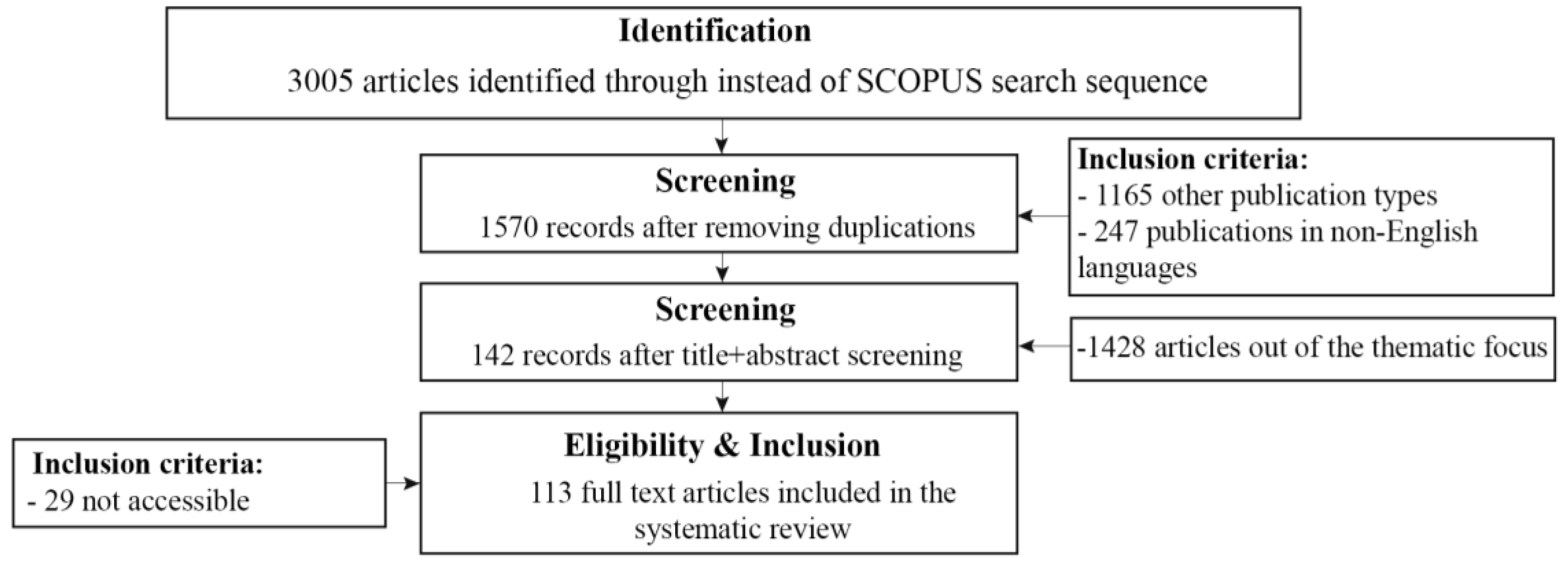
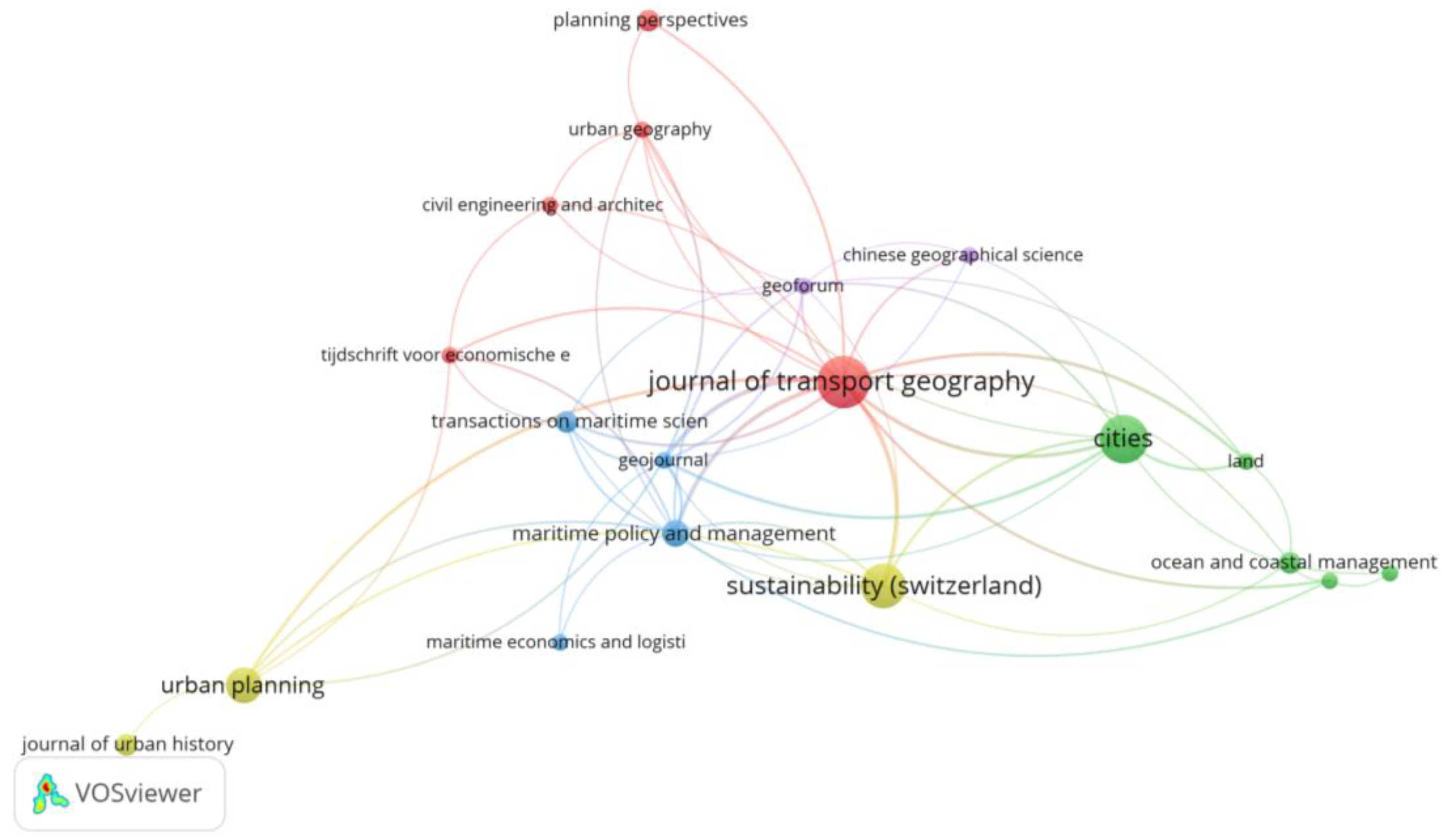
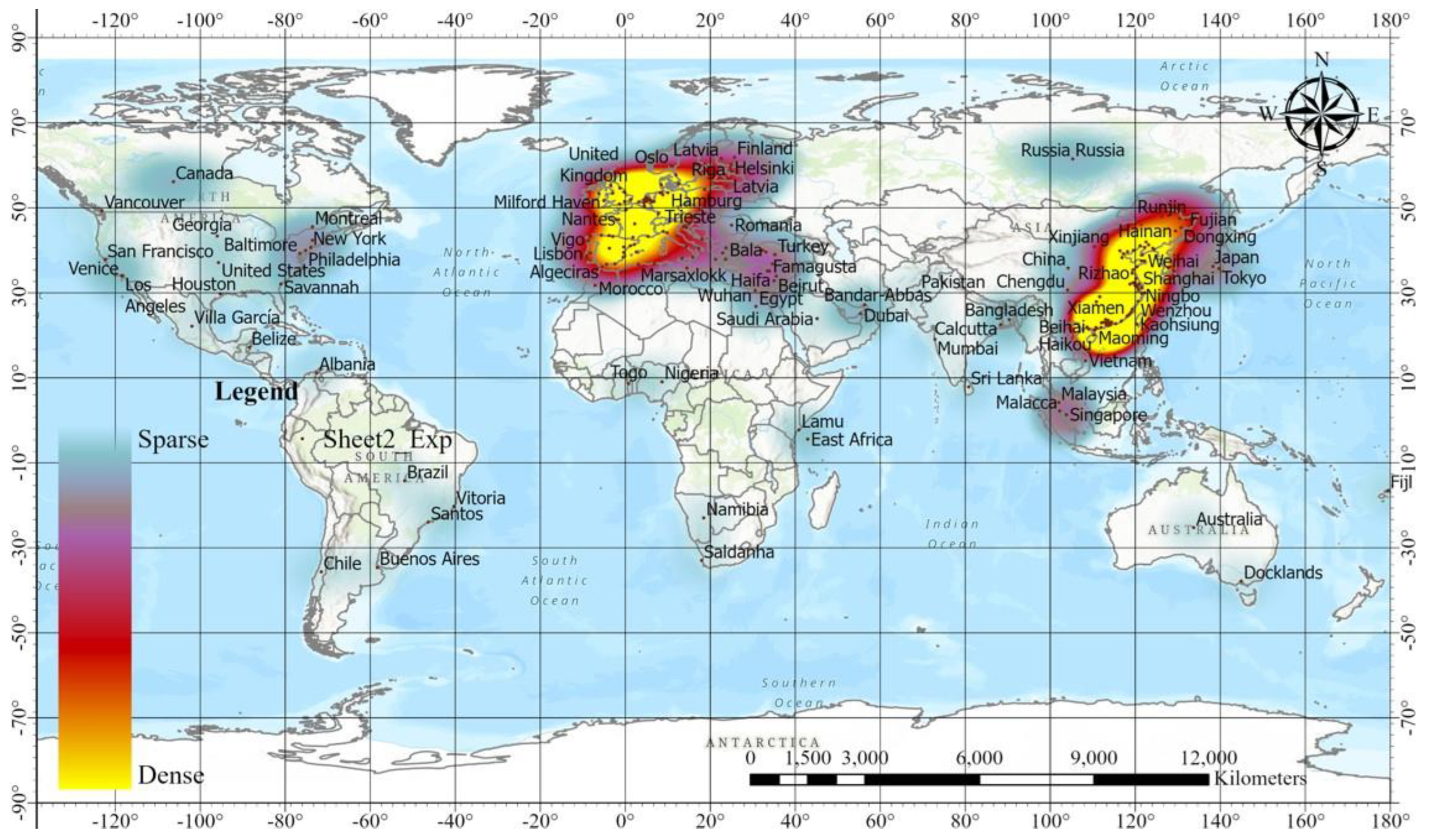
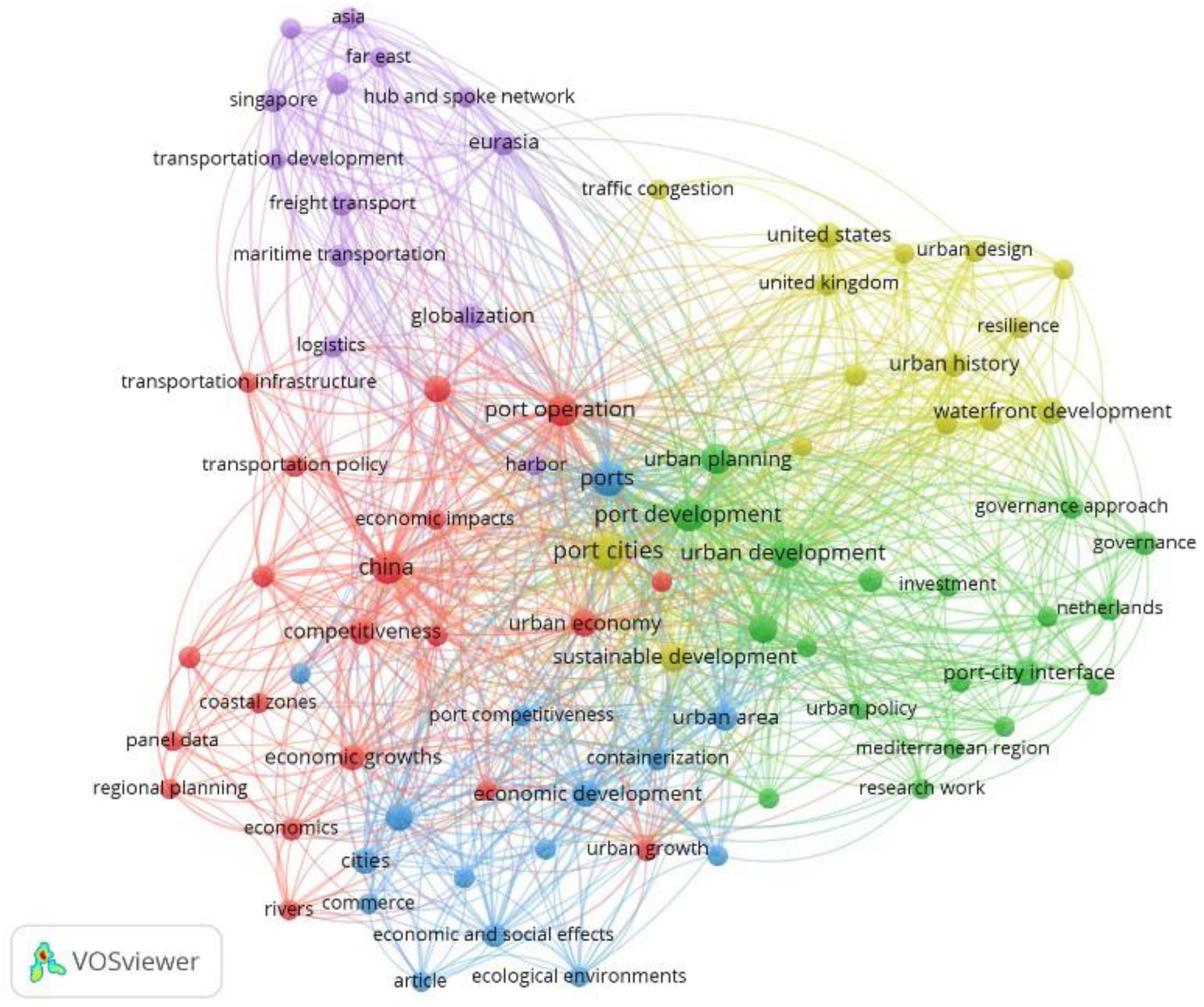
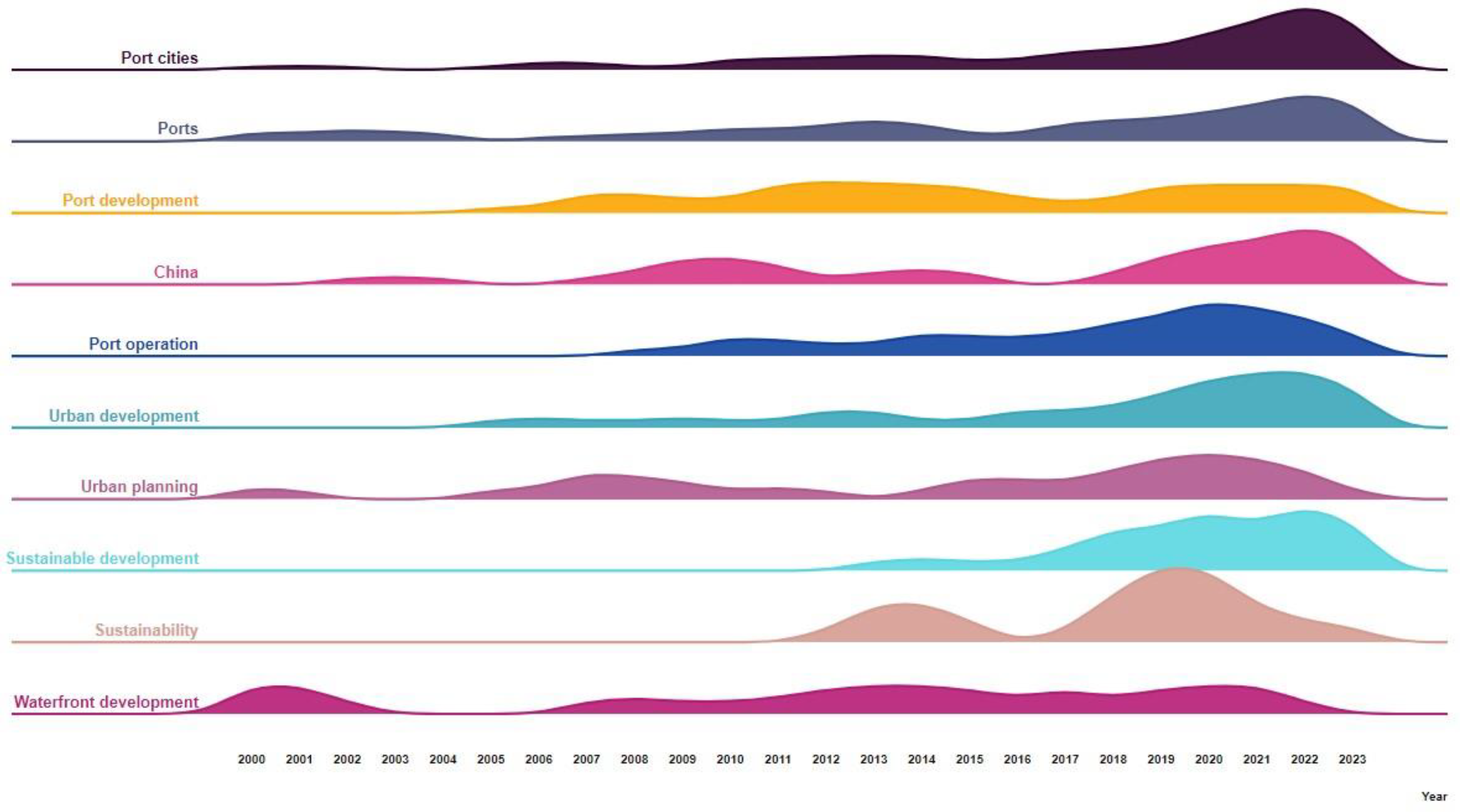
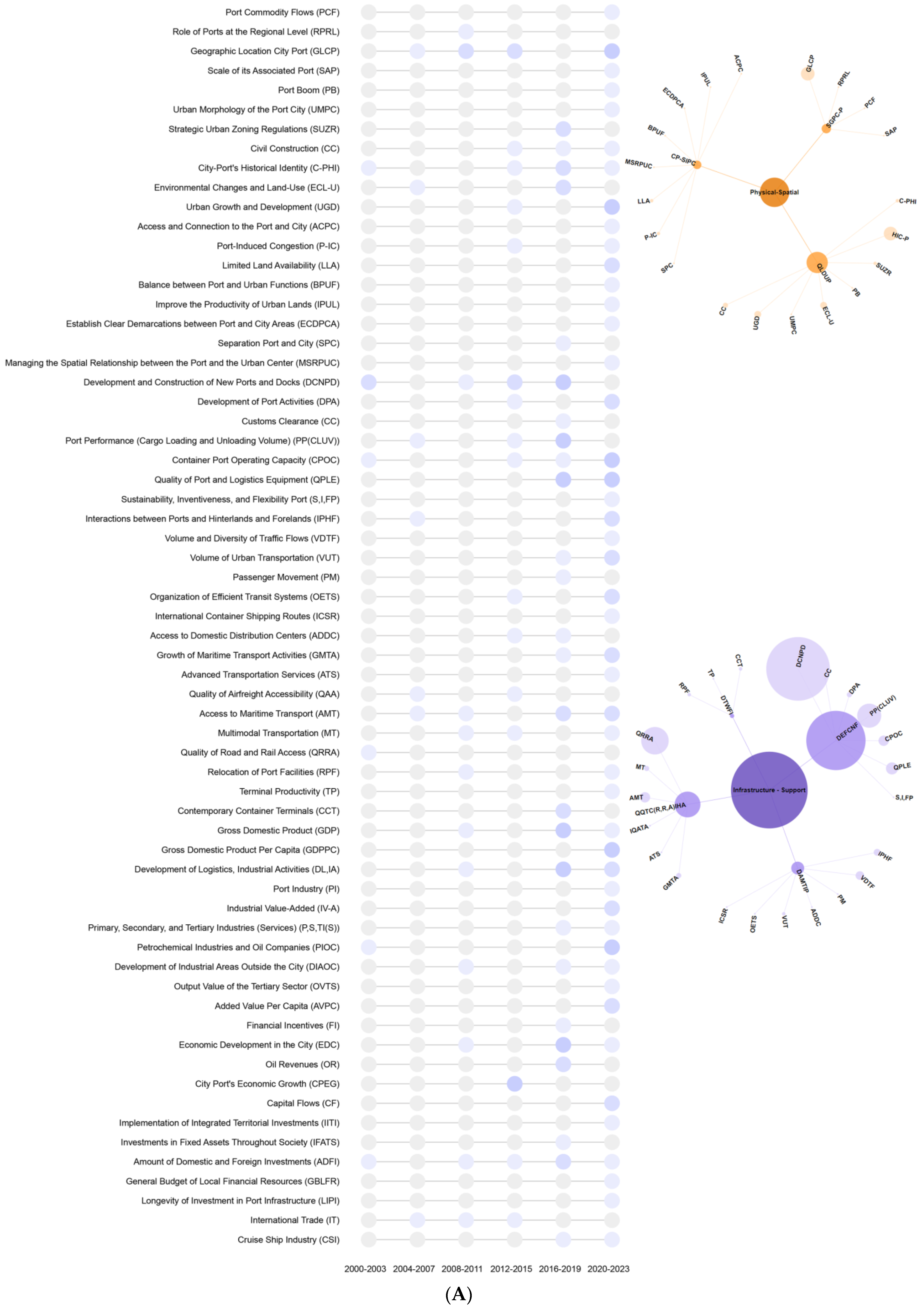
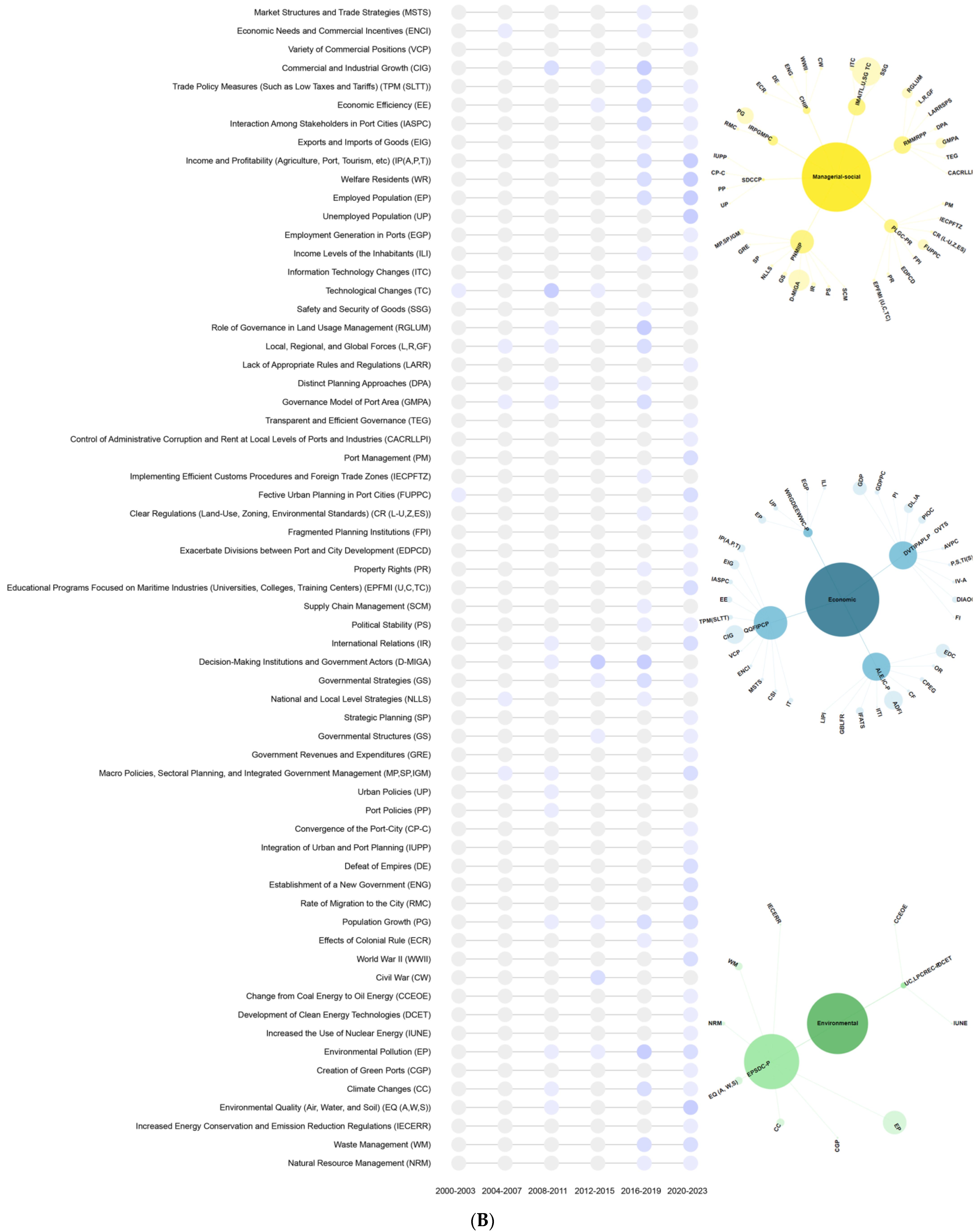
| Rank | Country | Documents | Citations | Total Link Strength |
|---|---|---|---|---|
| 1 | The Netherlands | 17 | 853 | 135 |
| 2 | China | 29 | 457 | 121 |
| 3 | United Kingdom | 7 | 428 | 45 |
| 4 | South Korea | 5 | 399 | 62 |
| 5 | Singapore | 7 | 285 | 65 |
| 6 | Hong Kong | 5 | 281 | 11 |
| 7 | France | 6 | 145 | 44 |
| 8 | Italy | 5 | 92 | 31 |
| 9 | Germany | 3 | 76 | 21 |
| 10 | United States | 5 | 71 | 25 |
| Type of Methodology | Research Methods | References | |
|---|---|---|---|
| Quantitative | Multi-Criteria Decision Analysis | DEMATEL | [31] |
| Fuzzy Analytic Hierarchy Process (FAHP) | [32] | ||
| Analytic Hierarchy Process (AHP) | [33] | ||
| Entropy Weight Method | [34] | ||
| Preference Ranking Organization Method for Enrichment Evaluation (PROMETHEE) | [32] | ||
| Best-Worst Method (BWM) | [32] | ||
| Simple Additive Weighting (SAW) | [35,36] | ||
| Complex Proportional Assessment (COPRAS) | [35,36] | ||
| Technique for Order Preference by Similarity to Ideal Solution (TOPSIS) | [35] | ||
| Descriptive Statistics | Tables and Charts | [37,38,39,40,41,42,43] | |
| Mathematical Models | [44] | ||
| Descriptive Models | Network Analysis | [17] | |
| Economic Models | [45] | ||
| Estimation Models | Spatial Econometric Methods | [46] | |
| Allometric Growth Model | [47] | ||
| Economic Geography Modelling | [48] | ||
| Quadratic Assignment Procedure | [49] | ||
| Super-Efficiency EBM-DEA Model | [50] | ||
| Forecast Models | Logistic Model | [46] | |
| Auto Regressive Moving Average (ARIMA) | [51] | ||
| Regression Analysis | [45,49,52,53,54,55,56,57] | ||
| Cellular Automata Model | [58] | ||
| Assessment Methods | Dynamic Centralization Index Model | [59] | |
| Coupling Coordination Degree Model | [60] | ||
| Synergy Degree Model | [55,61] | ||
| Triple Bottom Line | [31] | ||
| H-DEA Improved Aggregation Model | [31] | ||
| Panel Measurement Model | [62] | ||
| Data Envelopment Analysis | [63,64] | ||
| Super-Efficiency EBM-DEA Model | [50] | ||
| Evaluation Methods | In-VEST Model | [65] | |
| Modelling and Simulations | System Dynamics | [66,67,68,69,70] | |
| Comparative Methods | Double Difference Analysis Method | [71] | |
| Difference-in-Differences Regression Model | [72,73] | ||
| Difference-in-Differences Regression Model | [71,72,73] | ||
| Qualitative | Situational Analysis | Case Study | [11,74,75,76] |
| Comparative Geographic Analysis | [77,78,79,80,81,82,83,84,85,86,87] | ||
| Observational Analysis | Mapping Analysis | [88,89,90,91,92,93,94,95,96,97,98,99,100,101,102,103,104,105,106] | |
| Critical Analysis | Grounded Theory | [107,108] | |
| Content Analysis | Semi-Structured Interviews | [12,109,110,111,112,113,114] | |
| Deep Interviews | [110,115,116,117] | ||
| Structured Face to Face Interviews | [109,113,118] | ||
| Questionnaire survey and Interview | [119,120,121] | ||
| Transcribed and Coded | [23,24,122,123,124,125,126,127] | ||
| Mixed Method | Mixed Method | Mixed Quantitative and Qualitative Methods | [9,128,129,130,131,132,133,134,135,136] |
Disclaimer/Publisher’s Note: The statements, opinions and data contained in all publications are solely those of the individual author(s) and contributor(s) and not of MDPI and/or the editor(s). MDPI and/or the editor(s) disclaim responsibility for any injury to people or property resulting from any ideas, methods, instructions or products referred to in the content. |
© 2024 by the authors. Licensee MDPI, Basel, Switzerland. This article is an open access article distributed under the terms and conditions of the Creative Commons Attribution (CC BY) license (https://creativecommons.org/licenses/by/4.0/).
Share and Cite
Zarei, M.; Arasteh, M.; Shahab, S. Exploring Port–City Relationships: A Bibliometric and Content Analysis. Sustainability 2024, 16, 4341. https://doi.org/10.3390/su16114341
Zarei M, Arasteh M, Shahab S. Exploring Port–City Relationships: A Bibliometric and Content Analysis. Sustainability. 2024; 16(11):4341. https://doi.org/10.3390/su16114341
Chicago/Turabian StyleZarei, Melika, Mojtaba Arasteh, and Sina Shahab. 2024. "Exploring Port–City Relationships: A Bibliometric and Content Analysis" Sustainability 16, no. 11: 4341. https://doi.org/10.3390/su16114341
APA StyleZarei, M., Arasteh, M., & Shahab, S. (2024). Exploring Port–City Relationships: A Bibliometric and Content Analysis. Sustainability, 16(11), 4341. https://doi.org/10.3390/su16114341







